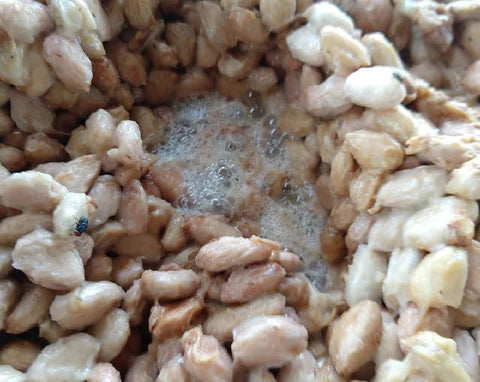Why is cacao fermented? What happens in the process and is it the fermentation that makes a cacao ceremonial? All this we take a closer look at in this article
Fermentation of cacao gives taste and special characteristics
Fermentation of cacao is an important part of the cacao beans' development of taste and acidity. It is said that if cacao is not fermented, it will not taste of anything at all. The fermentation process is thus a process that activates the cacao´s taste and bitterness - a refined process that we take a closer look at further down.
Ceremonial cocoa is not just cacao that has been fermented. All cacao that tastes of cacao is fermented without necessarily being taken into account the five requirements, required for cacao to be classified ceremonial.
Fermentation in a cacao shell
So it is a fermentation process that gives cacao its special characteristic taste, but what exactly is it that is fermented.
One would think that it is the cacao bean itself that is fermented, it is not. Outside each cacao bean lies the most delicious juicy pulp, baba, and that is what is fermented.
When the white pulp around the cacao beans is taken out of the cacao shell and placed in large vessels, where the fermentation is carried out, it comes into contact with bacteria, enzymes and other things from the environment. This starts and enables the actual fermentation, where heat, acid and enzymes are formed, all that changes and affecst the cacao bean from inside and out.
The fermentation proces is a specific and scientific process that can be controlled and targeted, depending on the acidity, bitterness and taste profile desired for the specific cacao.

Two different processes
Fermentation methods vary depending on regional preferences and availability of resources. Individual producers make different choices in the type and size of the amount of cacao pulp fermented, the number of days they ferment the cacao, how often they turn the cacao, how long the pulp is storaged before it is fermented and other factors.
But in general, all fermentation of cacao follows a similar process that contains both one anaerobic phase and one aerobic phase . The specific details of each step are influenced by a wide range of factors, not limited to the maturity of the cacao fruit, climate and weather conditions, quality and / or batch size.
The anaerobic phase
Anaerobic refers to a condition with a lack of oxygen.
The white pulp around the cacao bean creates a juicy barrier around the tightly packed beans that prevents air from entering the system. The pulp consists of water, high levels of sugar (sucrose, glucose, fructose) and various acids.
These sugars and the high acid content of the pulp create ideal conditions for microorganisms. Including yeast bacteria, lactic acid producing bacteria and pulp enzymes.
Due to the oxygen-poor environment, the yeast bacterias quickly eat simple sugars and produce carbon dioxide, ethanol and produce energy. Lactic acid-producing bacteria convert citric acid, glucose and other carbohydrates in the pulp into lactic acid. Microbes work around the clock to produce ethanol and lactic acid. After a few days, small bubbles of carbon dioxide gurgle up to the surface in this step.
This is where the cacao comes to life.

As a result of the decomposition of the pulp, a liquid begins to be seen running from the fermentation process. This is called the pulp starting to sweat . When the liquid runs off, the mass volume of the fermented pulp is reduced and some of the acid produced is also reduced. This raises the pH value of the mass and a greater flow of oxygen is added quite naturally.
The production of this fluid marks the transition to the second phase.
The aerobic phase
An aerobic state refers to a state that contains oxygen.
In this phase of the fermentation, large amounts of oxygen are added to the pulp. This is done by turning the cacao beans by hand by those responsible for the process.

The aerobic phase is characterized by the production of heat. During this phase, acetic acid-producing bacteria dominate the process. They oxidize ethanol and acids (citric acid, malic acid, lactic acid) to produce acetic acid. The acetic acid is further broken down into carbon dioxide and water.
Degradation of ethanol generates energy that creates heat, thereby increasing the overall temperature of the cacao. When the beans are turned over, some of the heat is given off and the overall temperature drops, but it then builds up again through the introduction of more oxygen.
It is at this point that care is constantly taken to ensure that the cacao does not exceed 42 degrees and, depending on the method used, a careful registration of the pulp temperature is carried out in order to obtain the desired taste profile in the final cacao.
The combination of intense heat and diffusion of ethanol and acetic acid in the cocoa beans breaks down the cell walls of the cocoa bean itself.
The cacao bean now no longer ferments and the damaged inner structure of the cocao bean becomes a place for chemical activities that develop the flavor precursors associated with, for example, Pachamama Cocoa or other chocolates.
How the cacao is turned, how much it is turned, how much heat is produced in the cacao, which bean variety is used and more all contribute to giving each cacao and chocolate, their individual taste character.
Pachamama cacao is of the Criollo variety. It ferments naturally faster and the whole above process lasts between 2-4 days.
Cacao is naturally bitter
The fermentation process is a necessary part of the cacao´s journey from fruit to the one you drink and / or eat. It is this process that develops the taste of the cacao.
Cacao beans are naturally bitter and slightly sharp in taste.
The exact taste profile of a cacao is created through refined processes and great knowledge of what is called fino y aroma .
Fino y aroma refers to the taste profile of the cacao, including how bitter, anti-strenuous, fruity, sweet, sour etc it is. As described above, this can be developed by regulating and knowing the individual steps and chemical processes in the two phases of the fermentation process.
When the cacao is fermented, it is sun-dried, after which the dried beans are run through a mill that separates pure cacao from cacao butter.
Also in this process, heat is created, which melts the cacao, which is then collected in blocks. At Pachamama Kakao, the cacao is afterwards chopped into mother earth beautiful pieces and sent out to you.
I really hope you have been able to use this article and that you are just as crazy about the taste of Pachamama Kakao as we are.
It is carefully selected and created for enjoyment, vitality and balance.
Blog: How To Create A Simple But Powerful cacao Ceremony at Home | No matter how busy you are

